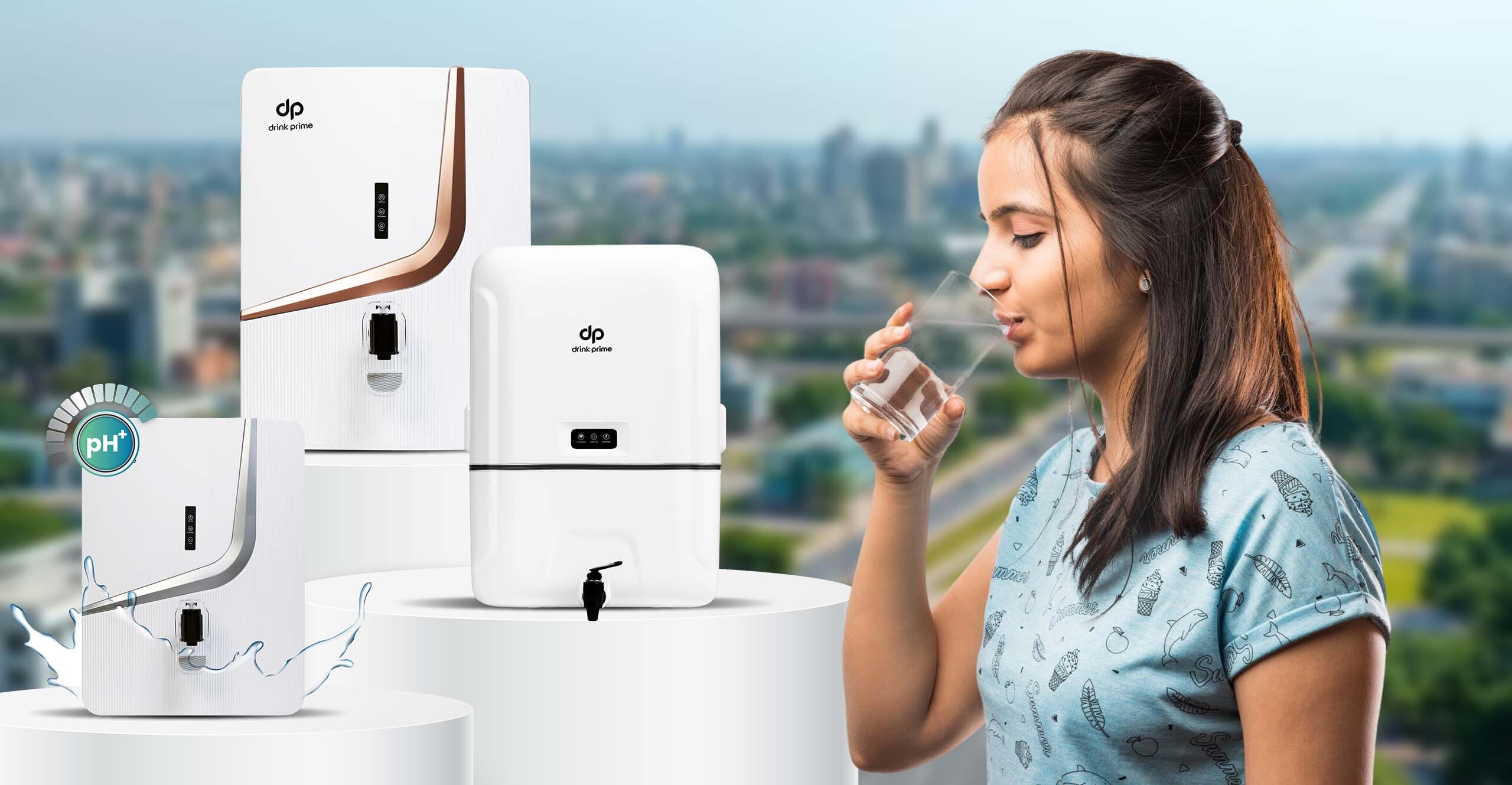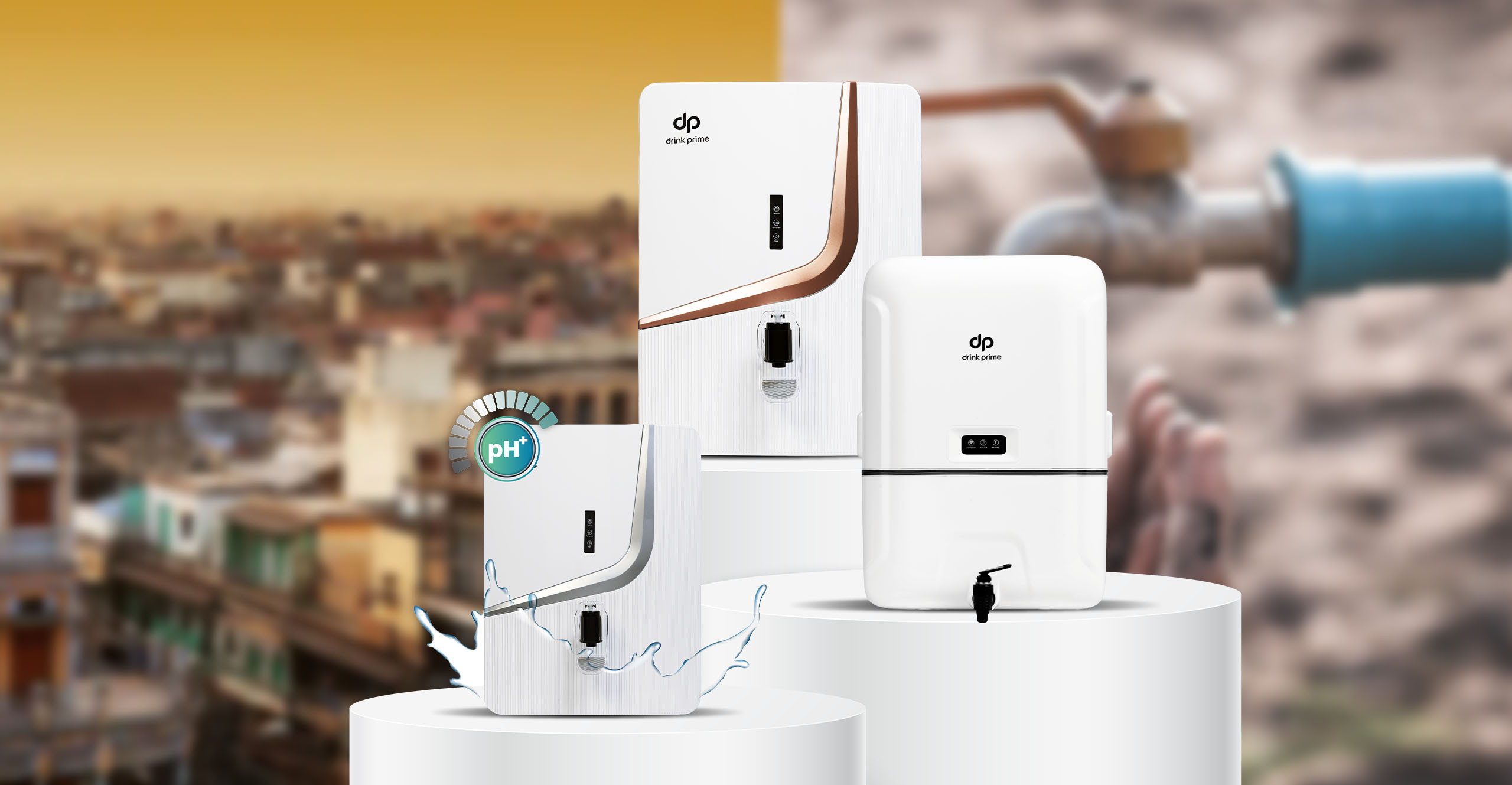Doyou find scales on your taps or utensils? Or, do you face any taste, odour, or other issues with your water? Well, you’re not alone. In fact, the majority of India deals with water-related issues in some form. With the growing population and increased urbanisation, access to safe drinking water is becoming quite difficult.
Let’s look at it in a little more detail.
Why do you need a water purifier in India?
Less than 50 percent of the Indian population has access to safe drinking water and almost two-thirds of the country’s 718 districts suffer from water depletion. Moreover, around 70% of the surface water in India is unfit for consumption. Adding to this problem of water scarcity is the extreme water pollution due to increased urbanization.
Even the groundwater isn’t safe because the pollutants find their way to the groundwater source due to poor planning and the absence of an effective pipe system.
According to UNICEF, almost 1.96 million dwellings in the country have chemical contamination of water. With the primary contaminants being fluoride and arsenic.
Fluoride alone affects millions of people across 19 states and it affects up to 15 million people in West Bengal. Arsenic, on the other hand, is quite prevalent in the water in the states of West Bengal, Jharkhand, Bihar, Uttar Pradesh, Assam, Manipur, and Chhattisgarh.
Similarly, there are water-borne diseases that not only affect millions of people but also add to an economic burden of about ₹44,69,22,00,000 in India annually.
Unfortunately, other than purification, not a lot of other solutions can help combat localised water quality issues.
For example, let’s take the water quality in a city like Bengaluru. The water quality can vary in the same city. So, if you live in a locality like KR Puram, you may have highly contaminated water with a TDS of more than 700 as opposed to Yeshwanthpur where you may find water with a TDS lower than 200. This too varies on a daily and monthly basis.
And this is just groundwater, other sources like tanker water can add to the already chaotic water quality levels in a single city.
So, all in all, India definitely requires water purifiers to ensure that you have access to safe drinking water.
Types of contaminants and their impact on health
Drinking contaminated water can adversely affect your and your family’s health. In fact, approximately 37.7 million Indians are affected by waterborne diseases every year.
These diseases are primarily caused by various harmful contaminants ranging from physical impurities like soil, mud, sand, etc. to many more like:
Inorganic contaminants
Inorganic contaminants commonly refer to heavy metal compounds like arsenic, lead, chlorine, fluoride, mercury, and much more. Additionally, chemicals like ammonia also contribute to the inorganic contaminant load in the water.
In addition to industrial effluents contributing to the spike in inorganic contaminants, these compounds can also be found naturally in both surface and groundwater sources. Moreover, they can even find their way into drinking water from the lining of the plumbing system.
Although these compounds are generally harmless in trace amounts, they can contribute to several health issues when consumed in high concentrations. For example, consuming water with high concentrations of arsenic can result in cancer of the lungs, bladder, kidney, and skin.
Organic contaminants
Organic contaminants, on the other hand, refer to both dissolved organic compounds such as plant/animal decay and insecticides, pesticides, and similar compounds. Even petroleum and detergents are considered organic compounds.
Drinking water with high concentrations of organic contaminants can lead to hormonal issues, cancers, and even nervous system disorders.
Biological contaminants
Microbial, parasitic, and living organisms take up a huge chunk of biological contaminants. Drinking water contaminated with viruses, bacteria, and protozoans can result in waterborne diseases like cholera, diarrhoea, typhoid, and viral hepatitis. They usually find their way into drinking water due to poor sanitation.
These diseases contribute to the most waterborne disease-related deaths in the country. Diarrhoea alone kills approximately 300,000 children in India each year.
Is filtration the only solution?
Well, filtration is the most effective solution. While there are alternatives like water cans and water bottles, these aren’t long-term solutions. Not to mention that water bottles are single-use and tend to contribute to a higher carbon footprint. And water in 20-litre plastic cans tends to come from questionable sources. So, they may not be contaminant-free.
Other methods such as boiling water may not only result in the loss of the nutritional value of water but it may not help you to thoroughly get rid of certain contaminants.
At the end of the day, it’s important to note that water qualities fluctuate from household to household and must be treated accordingly. So, a water purifier is your best bet.
How do water purifiers work?
Water purification has come a long way. What started as a simple method of purifying water using chlorine has lost its purpose, in a sense, as chlorine itself has become a contaminant. So, numerous water purification filters were developed to combat the drinking water problem at the household level.
All water purifiers essentially work the same way, the input water is passed through a filter that purifies the water before it’s collected in a storage tank. The impurities, on the other hand, are flushed out using another pipe. The filters used will vary depending on the technology.
Here’s how some of the most common types of water purifiers work:
Reverse Osmosis Filter: RO purifiers are popular because they happen to be highly effective. This multi-stage filtration process generally involves water passing through a membrane with minute pores. When it passes through the membrane, it effectively weeds out organic compounds, micro-organisms, dissolved chemicals, and impurities from water.
The contaminants are then collected and flushed out through an outlet pipe. Depending on the build of the water purifier, RO filters may be used in tandem with other filters like active carbon to get rid of any remaining impurities.
Ultraviolet (UV) Filter: UV filters, on the other hand, use a UV light to kill bacteria and microbes by destroying their DNA/RNA. It’s highly effective in filtering out pathogens. However, it’s not effective in removing particulate matter, odour, smell, or colour.
Ultrafiltration: UF filters are quite similar to RO filters as they use a semi-permeable layer as well. The only difference is the size of the molecules it retains. The molecules are much larger than an RO purifier. It is primarily used to filter out water that contains a small amount of contaminants.
Active Carbon Filter: Active carbon filters are equipped with porous charcoal that help absorb chlorine, pesticides, carbon monoxide, and dissolved gases. It even helps get rid of dead algae and organic compounds.
Moreover, the more effective Active carbon filters come with a lining of activated silver that helps kill bacteria. These filters are usually used in tandem with other filters.
What to look for when buying a water purifier?
While water purifiers do use a relatively effective filtration process, the technology does vary quite a bit. As a consumer, you may have a ton of options in terms of water purifier brands and their features. However, you do need to buy one that’s suitable for your specific needs.
When it comes to getting a water purifier, it should be about the quality of water it gives you. It shouldn’t be about who endorses the brand or how big the brand is. You must always look at the functionality of the water purifier. It should be able to perfectly purify water at all times.
After all, it does concern your health and your family’s well-being. So, here are some factors you absolutely need to consider before investing in a water purifier:
Input water quality
As mentioned earlier, the input water quality tends to fluctuate based on the source of the water. For example, two households in the same locality may have completely different water qualities. One household may be using municipal water whereas the other might depend on borewell for their water needs.
So, before you decide to invest in a water purifier, ensure that you at least check the water’s TDS, turbidity, and chloride levels.
While you do get DIY kits, it’s best to reach out to a professional lab if you notice certain characteristics like intense odour, colour, scales, or even changes in the taste.
As a general measure, it is recommended that you get a water purifier if the TDS is over 200 ppm. Water is especially hazardous to health if the TDS is over 1000 ppm.
Metro cities in India tend to depend on at least three types of water sources:
- Municipality water that reaches your home via rivers, lakes, and other sources. This type of water is usually treated but will still have varying levels of TDS.
- Groundwater that has a TDS level ranging from 200 ppm to a whopping 2000 ppm.
- And other miscellaneous sources like water tankers and water cans that can have a varying level of TDS and other contaminants.
Purification technology
Choosing the wrong water purification technology may result in you overspending on your water purifier even though it may be unnecessary. So, it’s always best to understand the level of contamination of your water source before you move on to the purification technology.
When it comes to purification technology, the most common types of water purifiers are the RO or Reverse Osmosis water purifiers, Ultraviolet water purifiers, and Ultrafiltration water purifiers. Of course, there are additional components like activated carbon filters that work in tandem with the above technology.
These filtration technologies essentially come with their own proprietary process to help purify varying levels of contaminants. For example, RO water purifiers use a permeable layer to filter out contaminants whereas UV water purifiers use ultraviolet light to kill microbes in the water. UF water purifiers, on the other hand, help remove larger particulate matter.
Some input water may even require a combination of two or all of these technologies.
Storage capacity
The storage capacity of the water purifier is another important factor that you need to consider when looking to buy a water purifier. The storage capacity is important as water purifiers are dependent on electricity and India has a ton of places with frequent power outages and fluctuations. So, you’ll need a reservoir of clean water in the event of a blackout.
As a rule of thumb, an individual must consume 5–8 litres of water on a daily basis. So, for 2–4 member households, we recommended you buy a water purifier of up to 10–15 litres of storage capacity.
Cost and maintenance
The price of the water purifier is something that you have to consider when you’re looking to buy a water purifier. As mentioned earlier, it’s best to focus on functionality rather than popular brand names with celebrity endorsements as these may be extremely expensive and it wouldn’t necessarily provide perfectly purified water.
Additionally, maintenance is something you’ll have to consider as part of your overall investment. Especially as the water purifier needs to be consistently maintained to provide safe drinking water. Most companies have an Annual Maintenance Cost (AMC) that can range from ₹4000-₹5000. This cost can stack up over time and can really burn a hole in your wallet. So, choose wisely.
Features
Any additional features that make your life more convenient are always worth looking into. For example, at DrinkPrime, we use the IoT(Internet of Things) to help us track your water purifier’s health. With this, we know when to schedule the maintenance check for your DrinkPrime. And with the DrinkPrime mobile app, you can also stay updated on your DrinkPrime’s health.
So, which water purifier should I choose?
Is this a question that has been bothering you? Well, ideally, you should buy a water purifier based on your source water quality. For example, if you live in a place like Whitefield, Bengaluru where the water is highly contaminated with TDS levels of over 500 ppm, then you should definitely look into getting the best of the best.
For example, a RO water purifier or a water purifier with a combination of technology depending on the level of toxicity would be your best bet.
However, not all water purifiers are perfect for you. In fact, the traditional water purifiers happen to purify all water in the same manner, resulting in under-purified or over-purified water. Both of which are bad for your health.
Most importantly, water purifiers are treated as commodities and home appliances. So, they stay out of reach from a large number of households in the country.
With DrinkPrime, we are trying to solve both these problems. Not only do we offer affordable monthly subscriptions starting at ₹339 but also customise your DrinkPrime to suit the source water quality in your household.



